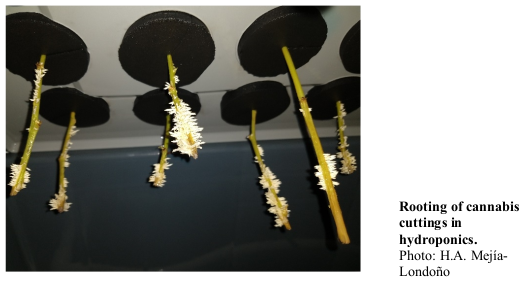Propagación asexual en plantas femeninas de cannabis (Cannabis sativa L.)

Resumen
Cannabis es una planta con tradición milenaria, y actualmente de interés mundial debido a la eficacia del cannabidiol (CBD) en diferentes tratamientos. Las técnicas de propagación asexual son usadas para preservar las características de las plantas madre. Este trabajo tuvo como objetivo evaluar la eficacia de dos métodos de siembra (hidroponía y turba) para la propagación asexual de plantas femeninas de cannabis usando el método del esquejado. Esquejes tomados de plantas femeninas fueron sometidos a dos métodos de siembra, adicionalmente se evaluaron dos factores, manejo del ápice y regulador hormonal en cada medio. Los esquejes se mantuvieron en condiciones controladas durante 17 días. Esquejes propagados en turba en combinación con el regulador de crecimiento registraron el mayor porcentaje de sobrevivencia (100%) con respecto al medio hidropónico sin regulador (73,33%). Los esquejes que no fueron sometidos al corte del ápice muestran los mejores resultados en las variables evaluadas en ambos medios de siembra. Tanto la turba como la hidroponía son medios efectivos para los esquejes. Aplicar un regulador de crecimiento y mantener las puntas de las hojas enteras favorecen la formación y calidad de las raíces.
Palabras clave
Cannabidiol, Esqueje, Ácido naftalenacetico, Hidrocultura
Citas
- Caplan, D., J. Stemeroff, M. Dixon, and Y. Zheng. 2018. Vegetative propagation of cannabis by stem cuttings: effects of leaf number, cutting position, rooting hormone, and leaf tip removal. Can. J. Plant Sci. 98(5), 1126-1132. Doi: https://doi.org/10.1139/cjps-2018-0038
- Cervantes, J. 2007. Marihuana: horticultura del cannabis. La biblia del cultivador médico de interior y exterior. 5th ed. Van Patten Publishing, Vancouver, WA.
- Chandra, S., H. Lata, and M.A. ElSohly. 2020. Propagation of cannabis for clinical research: an approach towards a modern herbal medicinal products development. Front. Plant Sci. 11, 958. Doi: https://doi.org/10.3389/fpls.2020.00958
- Chandra, S., H. Lata, I.A. Khan, and M.A. ElSohly. 2017. Cannabis sativa L.: botany and horticulture. pp. 79-100. In: Chandra, S., H. Lata, and M.A. ElSohly (eds.). Cannabis sativa L.: botany and biotechnology. Springer International Publishing, Cham, Switzerland. Doi: https://doi.org/10.1007/978-3-319-54564-6
- Chica, F., M. Gómez, E. Castro, S. Cardona, and Grupo Biotecnología. 2016. Parámetros de crecimiento y desarrollo fisiológico del crisantemo (Dendranthema grandiflorum (Ramat.) Kitam.), variedad Atlantis white bajo sistema aeropónico. Revista Universidad Católica de Oriente 29(41), 21-37.
- Clarke, R.C and M.D. Merlin. 2013. Cannabis: evolution and ethnobotany. University of California Press, Berkeley, CA.
- Cockson, P., G. Barajas, and B. Whipker. 2019. Enhancing rooting of vegetatively propagated Cannabis sativa “BaOx” cuttings. J. Agric. Hemp Res. 1(1), 2. https://digitalcommons.murraystate.edu/jahr/vol1/iss1/2
- Coffman, C.B. and W.A. Gentner. 1979. Greenhouse propagation of Cannabis sativaL. by vegetative cuttings. Econ. Bot. 33(2), 124-127. Doi: https://doi.org/10.1007/BF02858280
- Cox, S. 2020. Assessment of cannabinoid levels in successively cloned generations of industrial hemp (Cannabis sativa). MSc thesis. University Honors College, Buffalo, NY.
- De Backer, B., K. Maebe, A.G. Verstraete, and C. Charlier. 2012. Evolution of the content of THC and other major cannabinoids in drug-type cannabis cuttings and seedlings during growth of plants. J. Forensic Sci. 57(4), 918-922. Doi: https://doi.org/10.1111/j.1556-4029.2012.02068.x
- Grotenhermen, F. 2006. Los cannabinoides y el sistema endocannabinoide. Cannabinoids 1(1), 10-14.
- Hernández, R.J., H. Aramendiz, and C.E. Cardona. 2005. Influencia del ácido indolbutírico y ácido naftalenoacético sobre el enraizamiento de esquejes de caña flecha (Gynerium sagittatum Aubl.). Temas Agrarios 10(1) 5-13.
- Kodym, A. and C.J. Leeb. 2019. Back to the roots: protocol for the photoautotrophic micropropagation of medicinal Cannabis. Plant Cell Tissue Organ Cult. 138(2), 399-402. Doi: https://doi.org/10.1007/s11240-019-01635-1
- Lata, H., S. Chandra, I.A. Khan, and M.A. ElSohly. 2010. High frequency plant regeneration from leaf derived callus of high Δ9-tetrahydrocannabinol yielding Cannabis sativa L. Planta Med. 76(14), 1629-1633. Doi: https://doi.org/10.1055/s-0030-1249773
- Li, S.-W. 2021. Molecular bases for the regulation of adventitious root generation in plants. Front. Plant Sci. 12, 614072. Doi: https://doi.org/10.3389/fpls.2021.614072
- Ljung, K., R.P. Bhalerao, and G. Sandberg. 2002. Sites and homeostatic control of auxin biosynthesis in Arabidopsis during vegetative growth. Plant J. 28(4), 465-474. Doi: https://doi.org/10.1046/j.1365-313X.2001.01173.x
- Malamy, J.E. 2009. Lateral root formation. pp. 83-126. In: Beeckman, T. (ed.). Annual plant reviews. Vol. 37: root development. Wiley-Blackwell, Chichester, UK. Doi: https://doi.org/10.1002/9781444310023.ch4
- Molina, M.M. 2008. El cannabis en la historia: pasado y presente. Cultura y Droga 13(15), 95-110.
- Öpik, H., S.A. Rolfe, and A. Willis. 2005. The physiology of flowering plants. Cambridge University Press, UK. Doi: https://doi.org/10.1017/CBO9781139164450
- Small, E., T. Pocock, and P.B. Cavers. 2003. The biology of canadian weeds. 119. Cannabis sativa L. Can. J. Plant Sci. 83(1), 217-237. Doi: https://doi.org/10.4141/P02-021
- Vassilevska-Ivanova, R. 2019. Biology and ecology of genus Cannabis: genetic origin and biodiversity. In vitro production of cannabinoids. Genet. Plant Physiol. 9(1), 75-98. http://www.bio21.bas.bg/ippg/bg/wp-content/uploads/2019/12/GPP_9_1-2_2019_75-98.pdf
- Wahby, I. 2007. Aproximaciones biotecnológicas tendentes a la mejora del cáñamo (Cannabis sativa L.): obtención y cultivo de raíces transformadas, transformación genética y regeneración in vitro. PhD thesis. Facultad de Farmacia, Universidad de Granada, Granada, Spain.
- Wróbel, T., M. Dreger, K. Wielgus, and R. Słomski. 2022. Modified nodal cuttings and shoot tips protocol for rapid regeneration of Cannabis sativa L. J. Nat. Fibers 19(2), 536-545. Doi: https://doi.org/10.1080/15440478.2020.1748160
